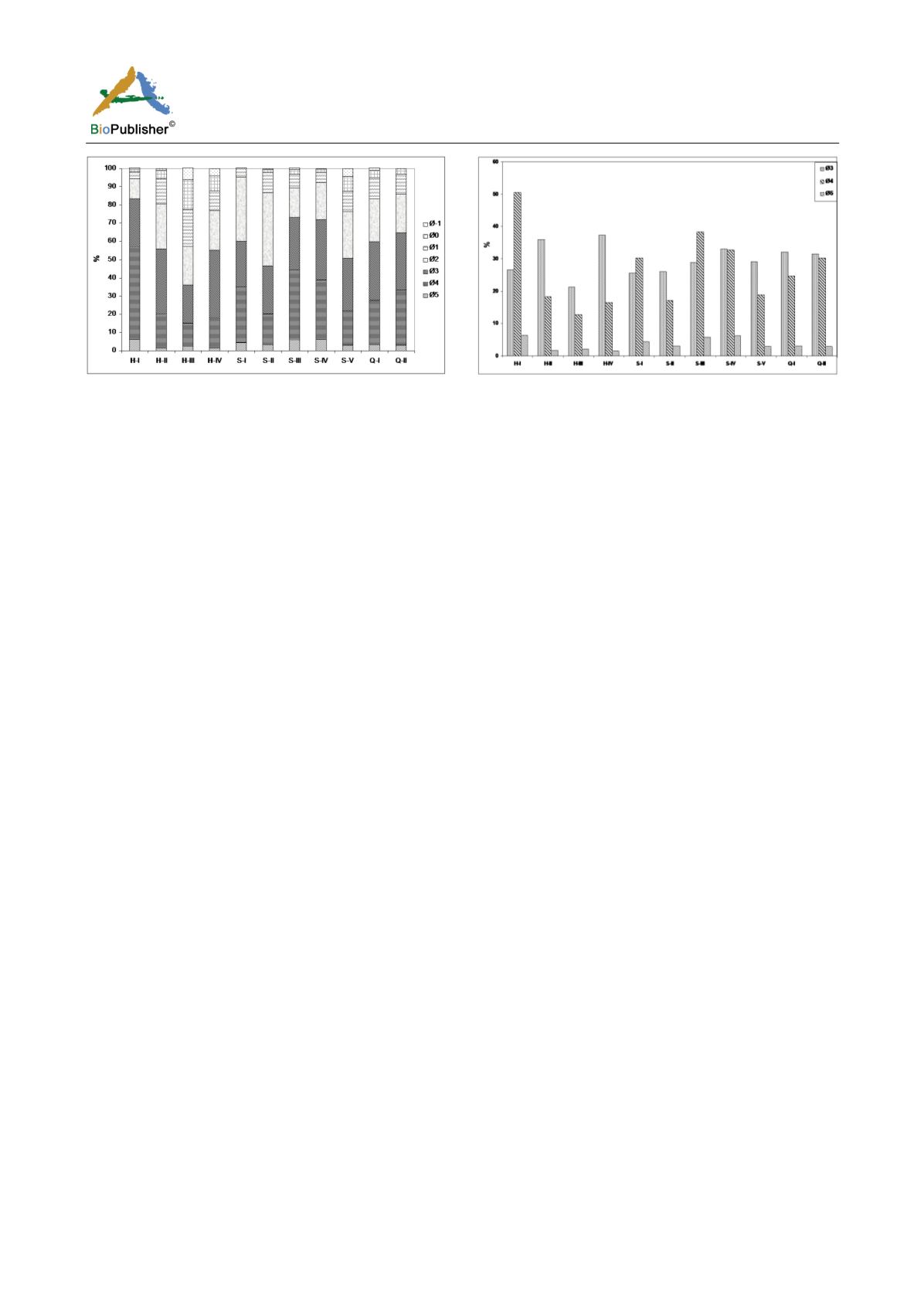
International Journal of Marine Science, 2017, Vol.7, No.23, 214-228
219
Figure 2 Distribution patterns of the different size fractions and the percentages of the finest fractions Ø3, Ø4 and Ø5 at the studied
ports
2.2.2 Distribution of leachable heavy metals and evaluation the biological risk
At Hurghada, the finest fraction Ø5 was the essential heavy metal carrier followed by Ø4 at the different ports
except passenger port, which was followed by Ø3. The marine area off Hurghada shipyard recorded significantly
high Fe, Mn, Zn, Cu, Ni and Pb in the finest fraction Ø5 (6556, 108.17, 330.38, 298.4, 91.40 and 101.02 µg/g,
respectively), meanwhile tourist marina recorded the lowest values. Fishing berth was followed the shipyard in the
heavy metal contents in the different fractions (Table 1). The metal accumulation at Hurghada ports was follow
the sequence Ø5> Ø4> Ø3. Dar et al. (2016b) and Madkour and Dar (2007) attributed the high accumulation of
heavy metals in the marine sediments off the shipyards to the repairing, maintaining, antifouling paint remains and
ship constructing. At Safaga, Fe showed relatively high values at the different wharfs relative to Hurghada and
Qusier due to the high amount of terrestrial runoff. The highest Fe and Cu were recorded in Ø5 (7483 and 62.58
µg/g, respectively) followed by Ø4 (6813 µg/g) for Fe at the grain wharf and Ø5 (54.70 µg/g) for Cu at passenger
terminal; the highest Mn was observed at passenger warf in Ø5 (306.3µg/g) followed by bauxite wharf in Ø3
(291.82 µg/g). The highest Zn in Ø3 (126.6 µg/g) followed by Ø5 (109.17 µg/g) was showed in front of bauxite
wharf. The highest Ni was in Ø3 (36.13 µg/g) in front of coal wharf, Pb was in Ø5 (22.52 µg/g) at orthoclase and
quartz wharf, meanwhile Co was observed in Ø5 (5.5 µg/g) at the navigation basin of bauxite wharf. The recorded
Cd at all wharfs was less than 2 µg/g. Dar et al. (2016b) concluded that the high Zn and Mn at Safaga marine area
attributed to the high quantities of pollutants rich in Zn from antifouling paint remains and Mn from the terrestrial
runoff from the phosphate shipments. At Qusier, the highest Fe and Zn was showed at the fishing basin in Ø5
(6207 and 80.53 µg/g, respectively) followed by Ø3 (5601 and 72.78 µg/g, respectively), the highest Mn and Cu
was showed in Ø5 (233.7 and 34.45 µg/g, respectively) in front of the old port. The highest Ni was recorded in Ø3
(73.30 µg/g) and Co was in Ø4 (5.85 µg/g) at the fishing basin, meanwhile Cd recorded the highest content in Ø5
(4.19 µg/g) at the old port. The marine area off the old port and fishing basin were highly affected by the
terrestrial runoff from the subsurface wastewater and coastal activities. The accumulation sequences of metals at
Safaga and Qusier were; Ø5> Ø3> Ø4.
It was interesting to observe that the distribution of Fe and Mn were generally lower in Hurghada area (significant
in most cases at p
≤
0.05) comparing to Safaga and Qusier stations (Figure 3). In consistence with our results,
previous work showed general elevated levels of Fe and Mn in sites which were used for shipping of ores,
especially phosphate and bauxite as reported in Safaga, Hamrawin and Qusier (Mansour et al., 2011; Madkour et
al., 2012; El-Metwally, 2015; Dar et al., 2016a; 2016b). Mn and Fe are essential elements and have relatively low
toxicology to aquatic organisms. The concentrations of Fe and Mn in all ports were very low compared with the
values of LEL (20,000 and 460 µg/g, respectively) and SEL (40,000 and 1100 µg/g, respectively). The values of
Fe in the present study were significantly lower than Port Kemblaharbour, Australia (He and Morrison, 2001),
while the recorded Mn values were comparable with those reported in Sydney Harbour (Irvine and Birch, 1998)
and Victoria Harbour (Wong et al., 1995; Tang et al., 2008) but were much lower than Hamilton Harbour (Poulton
et al., 1996). The Fe availability in this study was below that recorded in other harbours around the world (Table
2).


